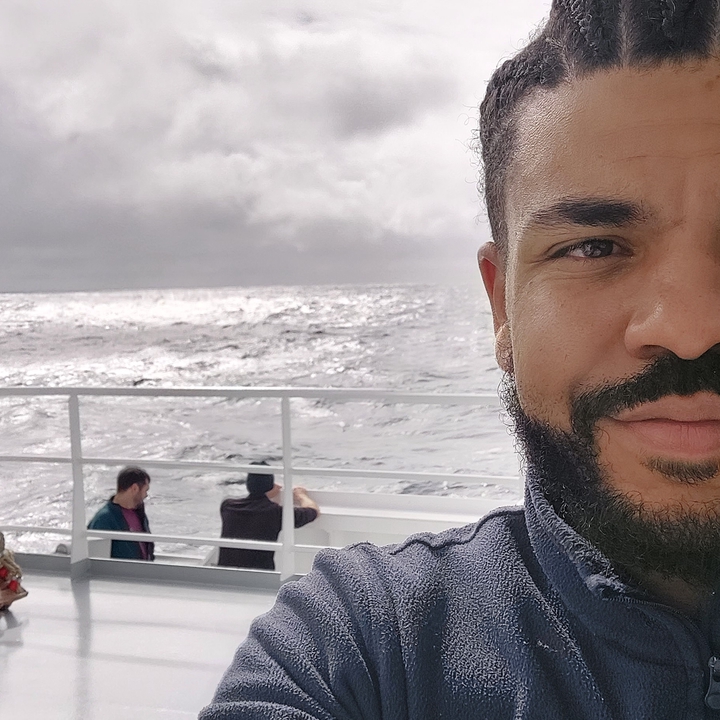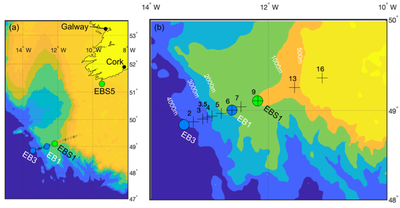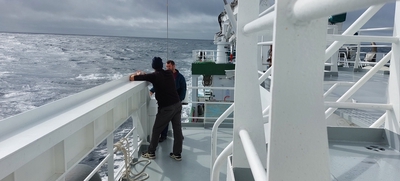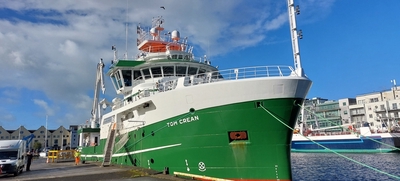Originally published at https://samueldi.github.io/.
The one-week long Aimsir/EirOOS survey ended a couple of weeks ago and was the first physical oceanography campaign of the new Irish Research Vessel (RV) Tom Crean. Our primary goal was to recover three moorings located southwest of Ireland, on an offshore underwater plateau known as Goban Spur. This campaign was carried out as a collaboration between three different ocean research institutions: 1) Maynooth University with scientists from the A4 project; 2) the Marine Institute; and 3) the Federal Maritime and Hydrographic Agency of Germany (in German, Bundesamt für Seeschifffahrt und Hydrographie, or BSH).
 Image credit: Sam T. Diabaté
Image credit: Sam T. DiabatéMoorings are instrument arrays anchored on the sea floor which sample the water column for an extended amount of time (from months to years). In recent years, a network of moorings has been measuring water properties at the Goban Spur (13°E, 49°N). In 2016, German scientists of BSH (the Federal Maritime and Hydrographic Agency of Germany) deployed three EB moorings on the deeper part of the Goban Spur, while in 2020, the Marine Institute filled in the gap between the German moorings and the Irish coastline with additional EBS moorings. The mooring geographical locations, reminding of the ‘OMEX’ mooring array deployed in the mid-90s, were chosen to close the eastern boundary of the NOAC line, a basinwide mooring array measuring the North Atlantic conveyor belt circulation.

While moorings EB2 and EBS3 were lost, possibly due to trawling activity, three Goban Spur moorings (EB3, EB1 and EBS1) and one shallow mooring (EBS5) sampled the ocean for an extended period. Recovery of these moorings was the primary goal of our cruise. These mooring locations are shown on the map above. The campaign was conducted on the RV Tom Crean between September 24th and 30th, and the principal investigator was Dr. Gerard McCarthy, my PhD supervisor.
The Maynooth University team, which was composed of Dr. Gerard McCarthy, Dr. Levke Caesar, Dr. André Düsterhus, Dr. Samantha Hallam, Dr. Stephen Ogungbenro and myself, met up with Dr. Manuela Köllner and Tobias Svensson from BSH on the Friday 23/09. We embarked the RV Tom Crean on the following day, joining Dr. Eoghan Daly, Alan Berry and Conall O' Malley from the Marine Institute as well as the ship’s crew. We set sail on that day. Mooring EB3 was recovered on Monday 26/09. Rougher weather hindered mooring recovery until the Thursday 29/09, and the elapsed time was used as best as possible to conduct CTD profiles (Don’t know what CTD stations are? Find out more info here).

Mooring EBS1 and EB1 were recovered on the Thursday 29/09, and it was decided to sail towards land immediately after because of the sea condition worsening. We fled ahead of the storm and reached — not without trouble — Galway Bay on the evening of Friday 29/09. We disembarked on the following morning.
Together with Dr. Samantha Hallam, I cleaned up the moored instruments recovered from the mooring lines, downloaded the data from the MicroCATs, set up the instruments for calibration dips, and more broadly facilitated the smooth running of the mooring operations headed by Dr. Manuela Köllner (for EB1 and EB3) and Conall O' Malley (for EBS1).I was also in charge of the Vessel Mounted Acoustic Doppler Current Profiler (VmADCP), which is an instrument designed to measure the water velocity (currents) of the water column below the ship keel. The VmADCP aboard the RV Tom Crean is a Pinnacle 45 from Teledyne RDI, a particularly modern instrument which allows to perform a novel acquisition method referred to as ‘interleaved’. This new method comes with new processing challenges, which I was able to circumvent with help of Pr. Jules Hummon of University of Hawaii who was contacted by mail. Next month, Gerard and I will be taking part in a workshop organised by Dr. Eoghan Daly on VmADCP acquisition and data processing.

The RV Tom Crean is a very modern ship, with a range of new assets to help scientists conduct research at sea. I was in particular impressed by the features of the dry laboratory. Scientists can now operate the CTD winch from a designated desk in the dry lab, provided the bridge has granted us control. The different screens in the lab are all connected to a central PC unit, and everything is accessible from a server, allowing researchers to quickly work on different ongoing measurements at a time (VmADC Profiling, but also swath bathymetry measurements, underway systems, CTD monitoring, etc.). The ship design makes life aboard comfortable and easy, with a gym, a TV space, a very comfortable dining room facing the galley, and plenty of room to work.
As on previous cruises I took part in, pods of common dolphins and pilot whales were common encounters. A camera was installed on the hull and allowed to see dolphins having great fun right beneath us. Colleagues Dr. Samantha Hallam and Alan Berry shared some wonderful footages on their social media, some of which can be seen below. Dr. Eoghan Daly also put together a video of our campaign which was shown during the RV Tom Crean commissioning ceremony, and it can be found below too.
Sam

No comments:
Post a Comment
Please note all comments are moderated. Comments containing profanities, unwarranted accusations, deemed off-topic etc. shall be deleted. There may be a substantial delay between posting a comment and its acceptance owing to moderator availability.